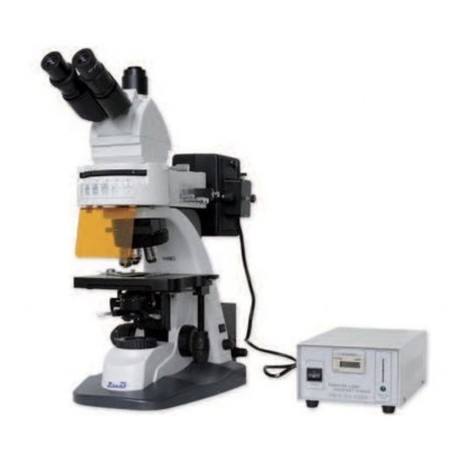



MODEL: SERIE 128, REVOLVER 4X, 10X, 40X, 100X MODEL 158/358
Certain substances under its chemical structure are able to emit light of a specific wavelength after absorbing light of a shorter wavelength.
Certain substances under its chemical structure are able to emit light of a specific wavelength after absorbing light of a shorter wavelength. This property is called fluorescence and is characteristic of certain molecules such as collagen, elastin, ligninga or chlorophyll and a number of chemical compounds, the fluorochromes (FITC, DAPI, TRITC) with numerous and varied applications, including two techniques routine laboratory and diagnostic research which is essential to use a fluorescence microscope.
- Immunofluorescence (IF) is the detection and marking of certain molecules and interest in biopsies or histological sections using specific antibodies conjugated with a specific fluorochrome allowing the diagnosis of certain diseases.
- Fluorescence In Situ Hybridization (FISH) involves hybridization of specific DNA fragments with probes labeled with fluorophores, allowing detection of mutations and genetic alterations and are thus useful in prenatal diagnosis and detection and diagnosis certain tumors.
| Reference | 50158358 |
|---|---|
| Head | Trinocular, adjustable angle 0-40 °, interpupillary distance adjustment (50-75 mm) and diopter correction |
| Optically | Infinity corrected |
| Eye | WF10x/20 |
| Revolver | Sextuple |
| Objectives | Plano apo-chromatic fluorescence |
| 4x A.N.: 0.15 | |
| 10x A.N.: 0.35 | |
| 40x (R) A.N.: 0.75 | |
| 100x (R) A.N.: 0.90 | |
| Platina | Mechanics double bed (18x16 cm) 80x50 mm displacement |
| Capacitor | ABBE condenser lens slide |
| Lighting | Koehler type with field and aperture diaphragms |
| Light-source | |
| Epi-fluorescence | High pressure lamp mercury 220V, 100W |
| Halogen 12V, 50W |
No customer reviews for the moment.